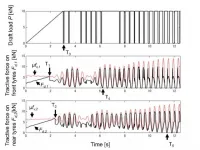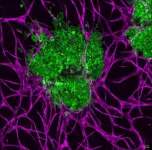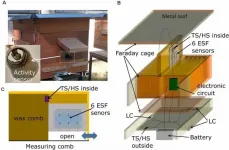(Press-News.org) Relatives of the giant crocodile might have been kings of the waterways during the Cretaceous period, eating anything--including dinosaurs--that got a little too close to the water's edge, but the largest of these apex predators still started off small. Figuring out how these little crocs grew up in a world surrounded by giants is no small task. Now crocs fossils from Texas are shedding light on how these animals changed their diets as they grew, helping them find a place of their own in environments alongside their bigger, badder relatives.
According to the study, published by Cambridge University Press, the crocodiless in question are members of the Deltasuchus motherali and lived along the coastline of Texas 96 million years ago. Previously known from a single adult skull, this 20-foot-long crocodile left behind bite marks on turtles and, yes, dinosaurs. The new discoveries include at least 14 more members of Deltasuchus, ranging from sizes as large as the original specimen down to a paltry (if still snappy) four feet in length.
Having so many crocs from the same fossil population is not common, and the smaller, more delicate bones of juveniles often did not survive the fossilization process.
"So many fossil groups are only known from one or a handful of specimens," said paleontologist Stephanie Drumheller, lead author of the study and a lecturer of earth and planetary sciences at the University of Tennessee, Knoxville. "It can be easy to fall into the trap of only thinking about the adults." The researchers ran into challenges piecing together this ancient ecosystem, however. Deltasuchus wasn't alone in its coastal swamps.
Living alongside Deltasuchus were other large crocs, like Terminonaris and Woodbinesuchus.
"These two large croc species were comparable in size to an adult Deltasuchus, but because they had long, narrow snouts with slender interlocking teeth, they were targeting smaller prey in the environment," said Thomas Adams, co-author of the new study and curator of paleontology and geology at the Witte Museum in San Antonio.
A smaller crocodile, Scolomastax, lived in the area as well, but its unusual jaw and chunky dentition hint that it preferred hard food and maybe even plants.
"These results confirm previous work that shows fossil crocs were much more diverse and creative when it came to coexisting in the same environments," said Chris Noto, co-author and associate professor at the University of Wisconsin-Parkside. "The very warm conditions of the Cretaceous supported a greater number of reptiles and allowed them to explore new niches not possible in the present day."
When these crocodiles died, their skeletons fell apart as they fossilized, getting jumbled together and complicating efforts to tell which bones went with which animal. To help solve this puzzle, the team turned to 3D scanning technology to help reconstruct the skulls. UT undergraduate student Hannah Maddox meticulously scanned each piece and stitched them together into 3D models of complete skulls.
"It was like solving a great puzzle," said Maddox. "Every piece brought you closer to seeing a toothy grin that hadn't been seen in millions of years."
As the models came together, a more complete picture of how Deltasuchus lived started to take shape.
The juveniles had lighter, skinnier snouts and teeth than their older relatives--faces better suited to snap up quicker, softer prey than the heavier, powerful jaws of their parents. This might have helped make sure that little Deltasuchus were not in direct competition with the similarly sized hard-prey specialists in their environments, but as they grew they had other neighbors to consider. The large-bodied, slender-snouted role was already filled by other species. So Deltasuchus shifted in another direction as it grew, bulking up and taking on the heavy jaws and sturdy teeth of an ambush predator.
"This is an amazing fossil discovery where we not only have a population of a single species, but in an ecosystem that has multiple predators coexisting by filling separate niches," said Adams.
Similar results were found in recent analyses of young tyrannosaurs, which spent their teenaged years outcompeting other medium-sized predators in their ecosystems.
INFORMATION:
CONTACT:
Amanda Womac (865-974-2992, awomac1@utk.edu)
Scientists have shed light on why some people who have a stroke do not also have abnormal heart rhythms, even though their hearts contain similar scar tissue.
Their results, published today in eLife, could help identify the best treatments for people who might be at risk of recurrent stroke, new heart disorders, or both.
Strokes are often caused by abnormal blood flow resulting from rapid, irregular beating in the upper chamber of the heart. This is also called atrial fibrillation (AFib). But some people have strokes that appear to have been caused by the heart, ...
Aachen, Germany and Hennigsdorf/Berlin, Germany, May 4, 2021 - German University Hospital Uniklinik RWTH Aachen ("Uniklinik RWTH Aachen") and diagnostics company SphingoTec GmbH ("SphingoTec") today announced that the endothelial function biomarker bio-ADM aids in the early risk stratification and management of patients suffering from severe COVID-19, in need for escalated intensive care treatment (1). A team lead by the clinical researchers at Uniklinik RWTH Aachen has shown that high bio-ADM levels indicate the severity of the acute respiratory distress ...
Tokyo, Japan - Researchers at Tokyo University of Agriculture and Technology (TUAT) modeled the dynamic instability--the so-called "power hop"--that can cause uncontrollable bouncing and damage tractors when they plow dry ground. The team found that self-excited oscillations can arise when the tractor pushes against the ground.
Plowing a field on a tractor may seem like a serene occupation, but sudden vibrations can grow unexpectedly and threaten to topple you under certain conditions. The problem is that in nonlinear systems with coupled components, as with a mechanical tractor, ...
A synthetic approach that improves absorber layers in perovskite solar cells could help them achieve their full potential and draw closer to the performance of leading gallium arsenide devices.
Solar cells that rely on perovskite thin films to capture sunlight are the fastest growing photovoltaic technology. Cheaper and easier to manufacture and incorporate into devices than conventional semiconductors, lead halide perovskites also effectively absorb visible light and display long charge carrier diffusion lengths -- an indicator of their ability to maintain light-induced electrons and holes separation and facilitate charge transport.
Performance ...
A new Boston University School of Public Health (BUSPH) study has identified for the first time how the aryl hydrocarbon receptor (AhR), an environmental chemical receptor, drives immunosuppression in oral squamous cell carcinoma (OSCC)--and that its removal from malignant cells can result in tumor rejection.
Published in the journal Proceedings of the National Academy of Sciences, the study findings provide new insight into the biology of cancer immunosuppression, and identify a new target for cancer immunotherapy treatment.
Immune checkpoint inhibitors (immunotherapy drugs) are some of the most important treatments that have emerged for treating many cancers, including OSCC. Targeting immune checkpoint molecules such as PD-1, ...
Measures to contain the Corona pandemic are the subject of politically charged debate and tend to polarize segments of the population. Those who support the measures motivate their acquaintances to follow the rules, while those who oppose them call for resistance in social media. But how exactly do politicization and social mobilization affect the incidence of infection? Researchers at the Max Planck Institute for Human Development have examined this question using the USA as an example. Their findings were published in Applied Network Science.
Limit crowds, keep a safe distance, and wear masks. Such non-pharmaceutical ...
Cancerous tumors thrive on blood, extending their roots deep into the fabric of the tissue of their host. They alter the genetics of surrounding cells and evolve to avoid the protective attacks of immune cells. Now, Penn State researchers have developed a way to study the relationship between solid, difficult-to-treat tumors and the microenvironment they create to support their growth.
The method has the potential to act as a testbed for drugs and other anticancer treatments, according to Ibrahim T. Ozbolat, associate professor of engineering science and mechanics and biomedical engineering, who led the research. The details of the approach were published in Advanced Biology.
Using ...
Despite human inventiveness and ingenuity, we still lag far behind the elegant and efficient solutions forged by nature over millions of years of evolution.
This also applies for buildings, where animals and plants, have developed extremely effective digging methods, for example, that are far more energy-efficient than modern tunnelling machines, and even self-repairing foundations that are unusually resistant to erosion and earthquakes (yep, we're talking about roots here).
Researchers from all over the world are therefore seeking inspiration in nature to develop the buildings of the future, and researchers from Aarhus University ...
Honeybees have a complex communication system. Between buzzes and body movements, they can direct hive mates to food sources, signal danger, and prepare for swarming - all indicators of colony health. And now, researchers are listening in.
Scientists based in Germany - with collaborators in China and Norway - have developed a way to monitor the electrostatic signals that bees give off. Basically, their wax-covered bodies charge up with electrostatic energy due to friction when flying, similar to how rubbing your hair can make it stand on end. That energy then gets emitted during communications.
"We were thrilled by the ...
The majority of top-rated fertility apps collect and even share intimate data without the users' knowledge or permission, a collaborative study by Newcastle University and Umea University has found.
Researchers are now calling for a tightening of the categorisation of these apps by platforms to protect women from intimate and deeply personal information being exploited and sold.
For hundreds of millions of women fertility tracking applications offer an affordable solution when trying to conceive or manage their pregnancy. But as this technology grows in popularity, experts have revealed that most of the top-rated fertility apps collect and share sensitive ...


